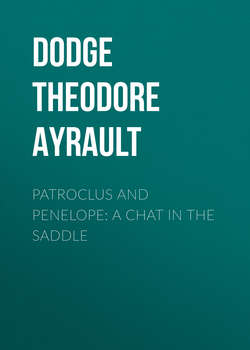Читать книгу Patroclus and Penelope: A Chat in the Saddle - Dodge Theodore Ayrault - Страница 5
IV
ОглавлениеThis running walk or rack, by the way, is one of the most delightful of gaits. Its universal adoption in the South by every one who can buy a racker is due to the roads, which, for many months of the year, are so utterly impassable that you have to pick your way in and out of the woods and fields on either side, and rarely meet a stretch where you can start into a swinging trot. But a horse will fall from a walk into a rack, or vice versa, with the greatest of ease to himself and rider, and if the stretch is but a hundred yards will gain some distance in that short bit of ground. If you have a fifty mile ride over good roads in comfortable weather, perhaps a smart trot, if easy, of course alternating with the walk, is as good a single gait as you can ride. But you need to trot or canter a goodly stretch, not to shorten rein at every dozen rods, for the transition from a walk to either of these gaits or back again, though slight, is still an exertion; while from the walk to the rack and back the change is so imperceptible that one is made conscious of it only by the patter of the horse's feet. Here again, the country's need, roads, and climate have bred a most acceptable gait. But it has made the Southerner forget what an inspiriting thing a swinging twelve-mile trot can be along a smooth and pretty road; and you cannot give away a trotting horse for use in the saddle south of Mason and Dixon. The rack soon grows into the single-foot, which only differs from it in being faster, and the latter is substituted for the trot. To go a six or eight mile gait, holding a full glass of water in the hand, and not to spill a drop, is the test of perfection in the racker. And for a lazy feeling day, or for hot weather, anywhere, it is the acme of comfort. Or it is, indeed, a useful gait in winter, when it is too cold for a clipped horse to walk and your nag has yet not stretched his legs enough to want to go at sharper speed. It must, however, be acknowledged that it is very rare that a horse will rack perfectly as well as trot. He is apt to get the gaits mixed.
A rack is half way between a pace and a trot. In the pace, the two feet of each side move and come down together; in the trot, the two alternate feet do so. In the running walk, or in the single-foot, each hind foot follows its leader at the half interval, no two feet coming to the ground together, but in regular succession, so as to produce just twice as many foot-falls as a trot or a pace. Hence the one, two, three, four, patter of the horse gives to the ear the impression of very great rapidity, when really moving at only half the apparent speed. The result of the step is a swaying, easy back, which you can sit with as much ease as a walk. Rackers will go a six-mile gait, single-footers much faster. I once owned a single-footing mare, who came from Alexander's farm and was sired by Norman, who could single-foot a full mile in three minutes. As a rule, the speed is not much more than half that rate. And either a rack or single-foot is apt to spoil the square trot; or if you break a horse to trot, you will lose the other gaits. A perfect all-day racker or a speedy single-footer can scarcely be aught else.
